2014 Hyundai Sonata ECU
[x] Cancel search: ECUPage 69 of 665
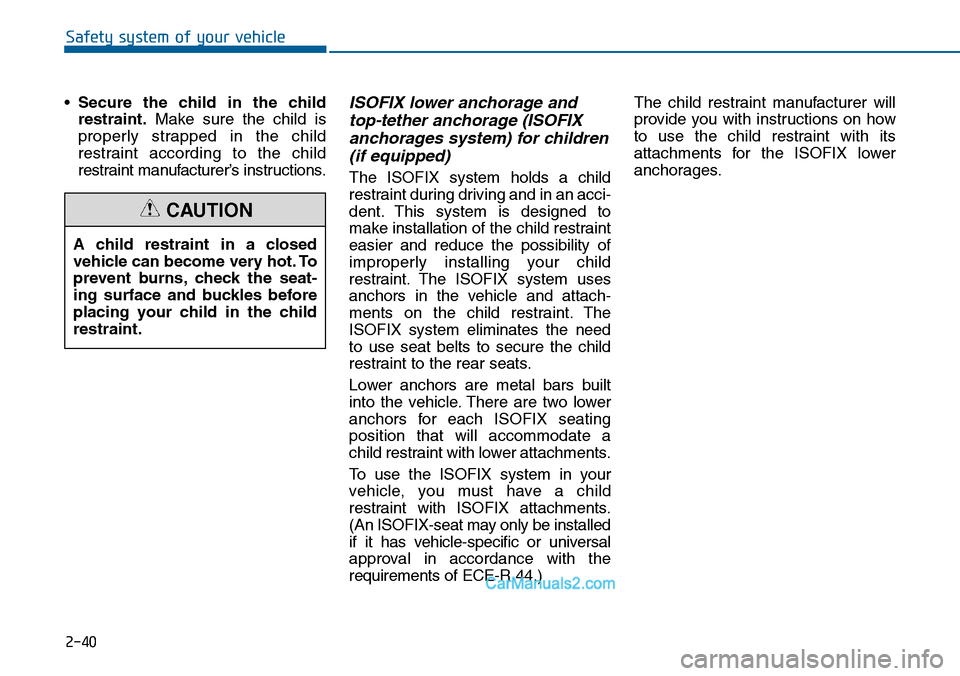
2-40
Safety system of your vehicle
•Secure the child in the child
restraint.Make sure the child is
properly strapped in the child
restraint according to the child
restraint manufacturer’s instructions.
ISOFIX lower anchorage and
top-tether anchorage (ISOFIX
anchorages system) for children
(if equipped)
The ISOFIX system holds a child
restraint during driving and in an acci-
dent. This system is designed to
make installation of the child restraint
easier and reduce the possibility of
improperly installing your child
restraint. The ISOFIX system uses
anchors in the vehicle and attach-
ments on the child restraint. The
ISOFIX system eliminates the need
to use seat belts to secure the child
restraint to the rear seats.
Lower anchors are metal bars built
into the vehicle. There are two lower
anchors for each ISOFIX seating
position that will accommodate a
child restraint with lower attachments.
To u s e t h e I S O F I X s y s t e m i n y o u r
vehicle, you must have a child
restraint with ISOFIX attachments.
(An ISOFIX-seat may only be installed
if it has vehicle-specific or universal
approval in accordance with the
requirements of ECE-R 44.)
The child restraint manufacturer will
provide you with instructions on how
to use the child restraint with its
attachments for the ISOFIX lower
anchorages.
A child restraint in a closed
vehicle can become very hot. To
prevent burns, check the seat-
ing surface and buckles before
placing your child in the child
restraint.
CAUTION
Page 71 of 665
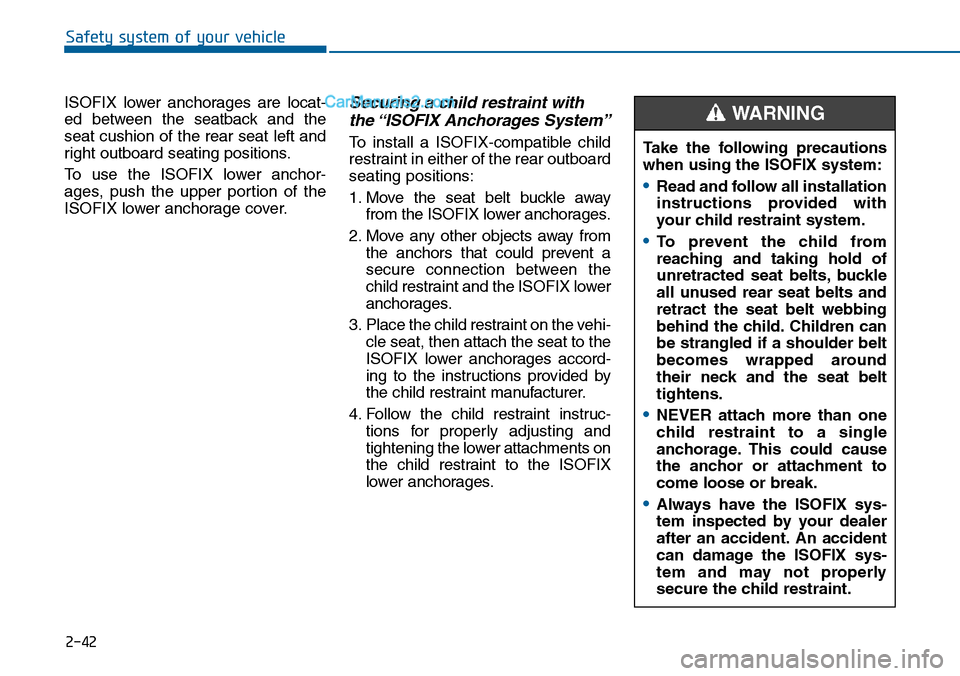
2-42
Safety system of your vehicle
ISOFIX lower anchorages are locat-
ed between the seatback and the
seat cushion of the rear seat left and
right outboard seating positions.
To use the ISOFIX lower anchor-
ages, push the upper portion of the
ISOFIX lower anchorage cover.
Securing a child restraint with
the “ISOFIX Anchorages System”
To install a ISOFIX-compatible child
restraint in either of the rear outboard
seating positions:
1. Move the seat belt buckle away
from the ISOFIX lower anchorages.
2. Move any other objects away from
the anchors that could prevent a
secure connection between the
child restraint and the ISOFIX lower
anchorages.
3. Place the child restraint on the vehi-
cle seat, then attach the seat to the
ISOFIX lower anchorages accord-
ing to the instructions provided by
the child restraint manufacturer.
4. Follow the child restraint instruc-
tions for properly adjusting and
tightening the lower attachments on
the child restraint to the ISOFIX
lower anchorages.
Ta k e t h e f o l l o w i n g p r e c a u t i o n s
when using the ISOFIX system:
•Read and follow all installation
instructions provided with
your child restraint system.
•To p r e v e n t t h e c h i l d f r o m
reaching and taking hold of
unretracted seat belts, buckle
all unused rear seat belts and
retract the seat belt webbing
behind the child. Children can
be strangled if a shoulder belt
becomes wrapped around
their neck and the seat belt
tightens.
•NEVER attach more than one
child restraint to a single
anchorage. This could cause
the anchor or attachment to
come loose or break.
•Always have the ISOFIX sys-
tem inspected by your dealer
after an accident. An accident
can damage the ISOFIX sys-
tem and may not properly
secure the child restraint.
WARNING
Page 72 of 665
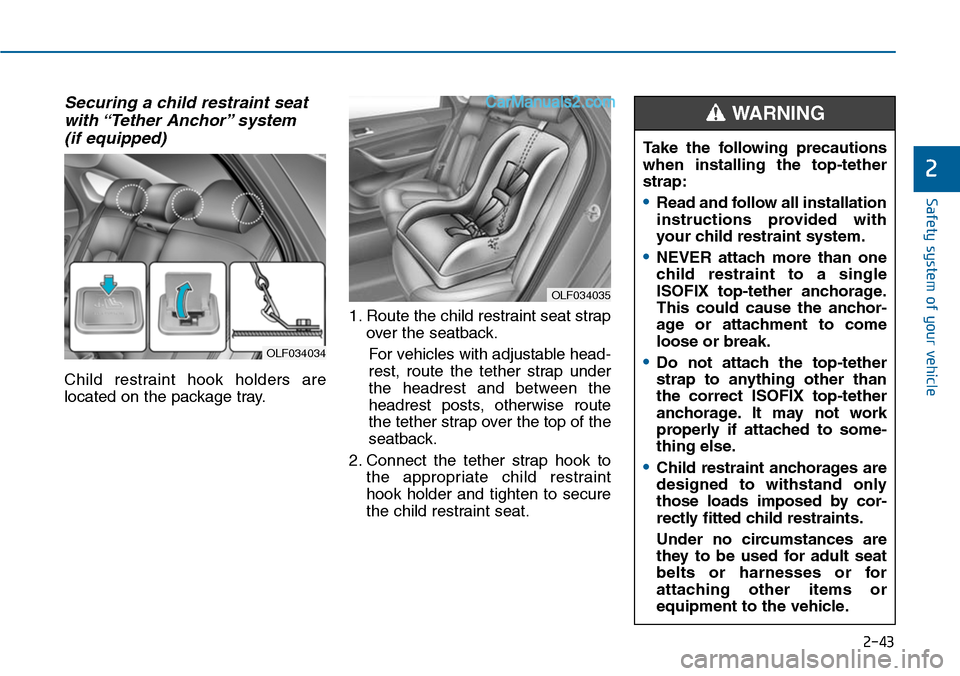
2-43
Safety system of your vehicle
2
Securing a child restraint seat
with “Tether Anchor” system
(if equipped)
Child restraint hook holders are
located on the package tray.
1. Route the child restraint seat strap
over the seatback.
For vehicles with adjustable head-
rest, route the tether strap under
the headrest and between the
headrest posts, otherwise route
the tether strap over the top of the
seatback.
2. Connect the tether strap hook to
the appropriate child restraint
hook holder and tighten to secure
the child restraint seat.
OLF034034
OLF034035
Ta k e t h e f o l l o w i n g p r e c a u t i o n s
when installing the top-tether
strap:
•Read and follow all installation
instructions provided with
your child restraint system.
•NEVER attach more than one
child restraint to a single
ISOFIX top-tether anchorage.
This could cause the anchor-
age or attachment to come
loose or break.
•Do not attach the top-tether
strap to anything other than
the correct ISOFIX top-tether
anchorage. It may not work
properly if attached to some-
thing else.
•Child restraint anchorages are
designed to withstand only
those loads imposed by cor-
rectly fitted child restraints.
Under no circumstances are
they to be used for adult seat
belts or harnesses or for
attaching other items or
equipment to the vehicle.
WARNING
Page 74 of 665
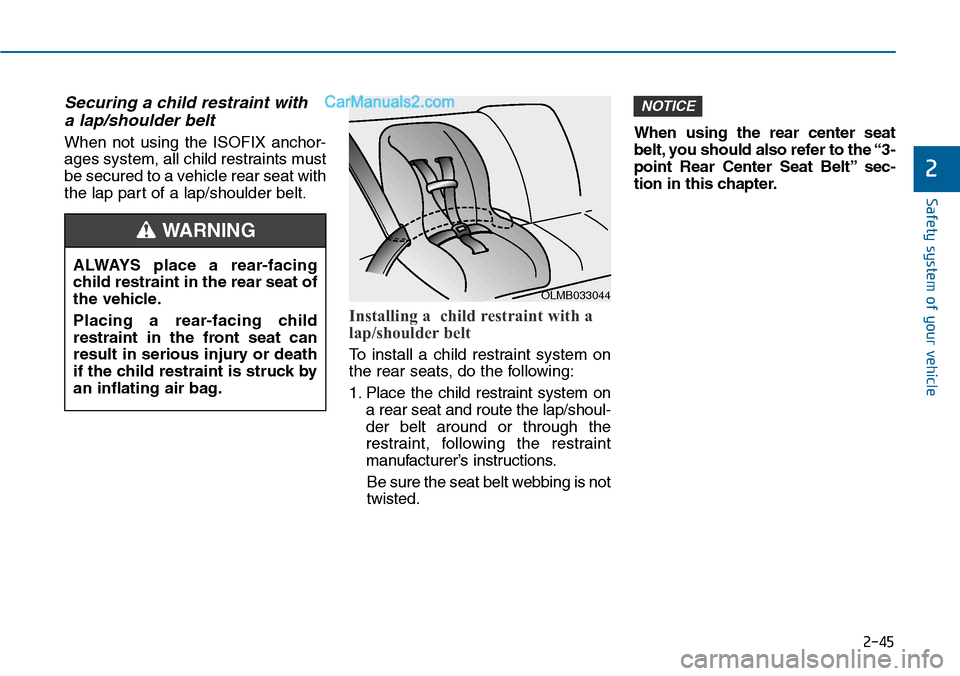
2-45
Safety system of your vehicle
2
Securing a child restraint with
a lap/shoulder belt
When not using the ISOFIX anchor-
ages system, all child restraints must
be secured to a vehicle rear seat with
the lap part of a lap/shoulder belt.
Installing a child restraint with a
lap/shoulder belt
To install a child restraint system on
the rear seats, do the following:
1. Place the child restraint system on
a rear seat and route the lap/shoul-
der belt around or through the
restraint, following the restraint
manufacturer’s instructions.
Be sure the seat belt webbing is not
twisted.
When using the rear center seat
belt, you should also refer to the “3-
point Rear Center Seat Belt” sec-
tion in this chapter.
NOTICE
ALWAYS place a rear-facing
child restraint in the rear seat of
the vehicle.
Placing a rear-facing child
restraint in the front seat can
result in serious injury or death
if the child restraint is struck by
an inflating air bag.
WARNING
OLMB033044
Page 82 of 665
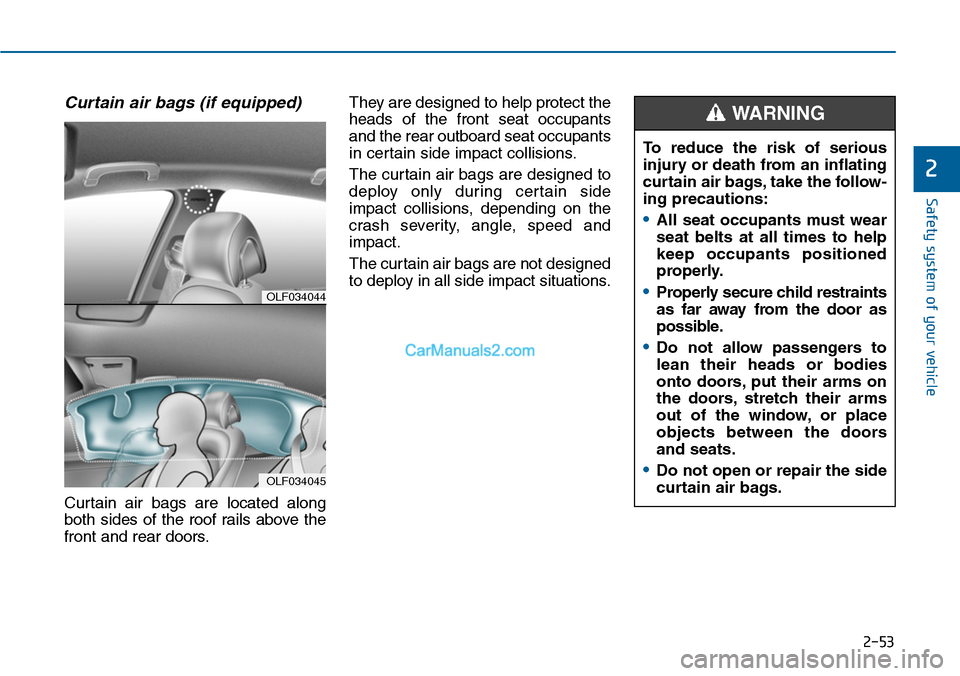
2-53
Safety system of your vehicle
2
Curtain air bags (if equipped)
Curtain air bags are located along
both sides of the roof rails above the
front and rear doors.
They are designed to help protect the
heads of the front seat occupants
and the rear outboard seat occupants
in certain side impact collisions.
The curtain air bags are designed to
deploy only during certain side
impact collisions, depending on the
crash severity, angle, speed and
impact.
The curtain air bags are not designed
to deploy in all side impact situations.OLF034044
OLF034045
To reduce the risk of serious
injury or death from an inflating
curtain air bags, take the follow-
ing precautions:
•All seat occupants must wear
seat belts at all times to help
keep occupants positioned
properly.
•Properly secure child restraints
as far away from the door as
possible.
•Do not allow passengers to
lean their heads or bodies
onto doors, put their arms on
the doors, stretch their arms
out of the window, or place
objects between the doors
and seats.
•Do not open or repair the side
curtain air bags.
WARNING
Page 110 of 665
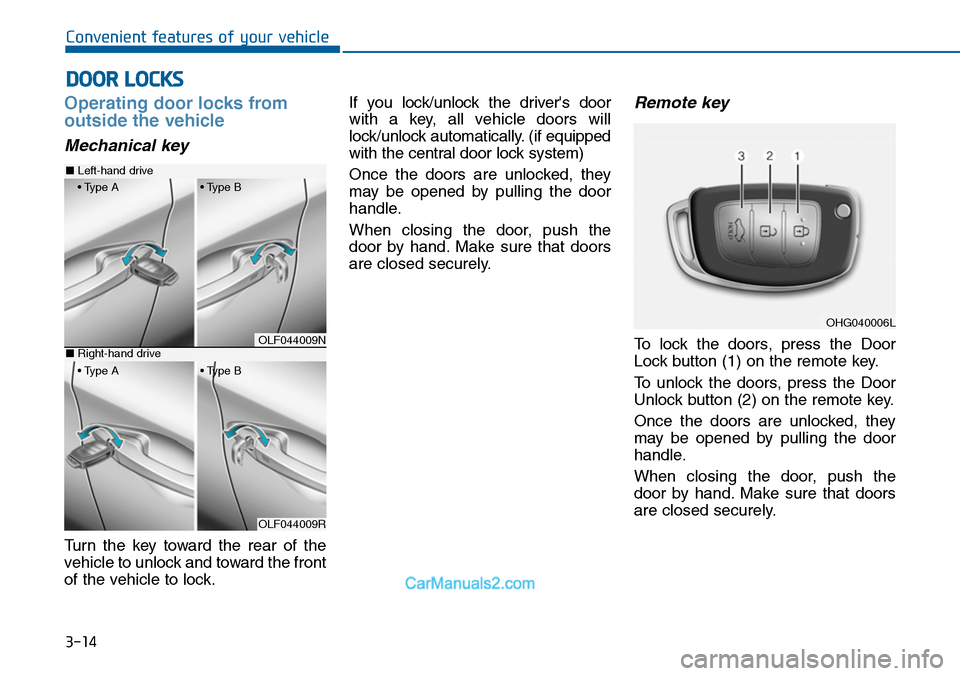
3-14
Convenient features of your vehicle
Operating door locks from
outside the vehicle
Mechanical key
Turn the key toward the rear of the
vehicle to unlock and toward the front
of the vehicle to lock.
If you lock/unlock the driver's door
with a key, all vehicle doors will
lock/unlock automatically. (if equipped
with the central door lock system)
Once the doors are unlocked, they
may be opened by pulling the door
handle.
When closing the door, push the
door by hand. Make sure that doors
are closed securely.
Remote key
To lock the doors, press the Door
Lock button (1) on the remote key.
To unlock the doors, press the Door
Unlock button (2) on the remote key.
Once the doors are unlocked, they
may be opened by pulling the door
handle.
When closing the door, push the
door by hand. Make sure that doors
are closed securely.
DOOR LOCKS
OLF044009N
OLF044009R
■Left-hand drive
• Type A • Type B
■Right-hand drive
• Type A • Type B
OHG040006L
Page 111 of 665
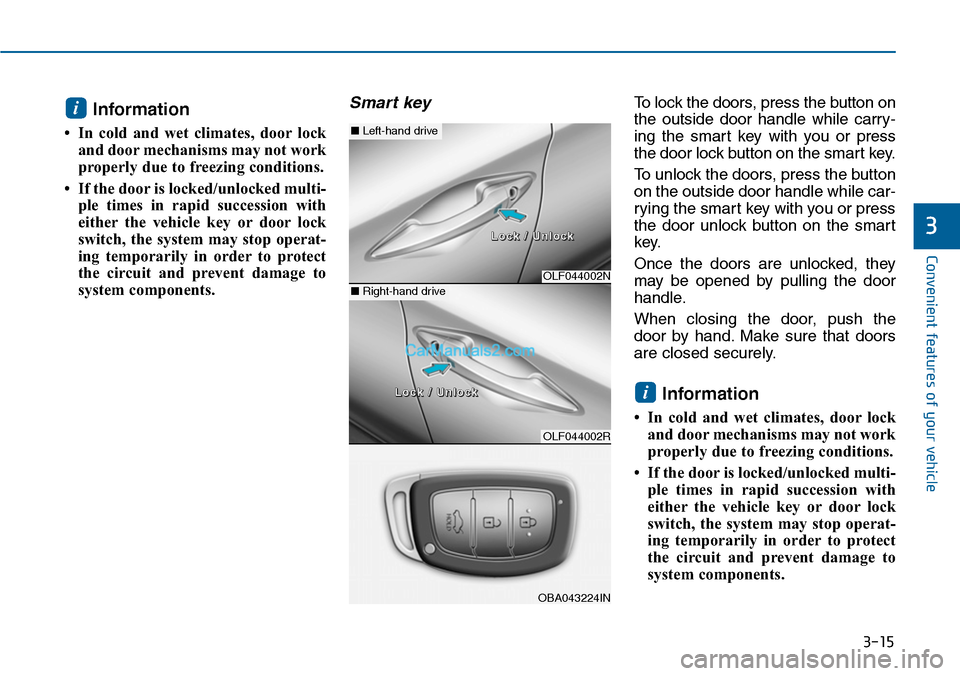
3-15
Convenient features of your vehicle
3
Information
• In cold and wet climates, door lock
and door mechanisms may not work
properly due to freezing conditions.
• If the door is locked/unlocked multi-
ple times in rapid succession with
either the vehicle key or door lock
switch, the system may stop operat-
ing temporarily in order to protect
the circuit and prevent damage to
system components.
Smart key To l o c k t h e d o o r s , p r e s s t h e b u t t o n o n
the outside door handle while carry-
ing the smart key with you or press
the door lock button on the smart key.
To unlock the doors, press the button
on the outside door handle while car-
rying the smart key with you or press
the door unlock button on the smart
key.
Once the doors are unlocked, they
may be opened by pulling the door
handle.
When closing the door, push the
door by hand. Make sure that doors
are closed securely.
Information
• In cold and wet climates, door lock
and door mechanisms may not work
properly due to freezing conditions.
• If the door is locked/unlocked multi-
ple times in rapid succession with
either the vehicle key or door lock
switch, the system may stop operat-
ing temporarily in order to protect
the circuit and prevent damage to
system components.
i
i
OLF044002N
OLF044002R
■Left-hand drive
■Right-hand drive
LLoocckk // UUnnlloocckk
LLoocckk // UUnnlloocckk
OBA043224IN
Page 114 of 665
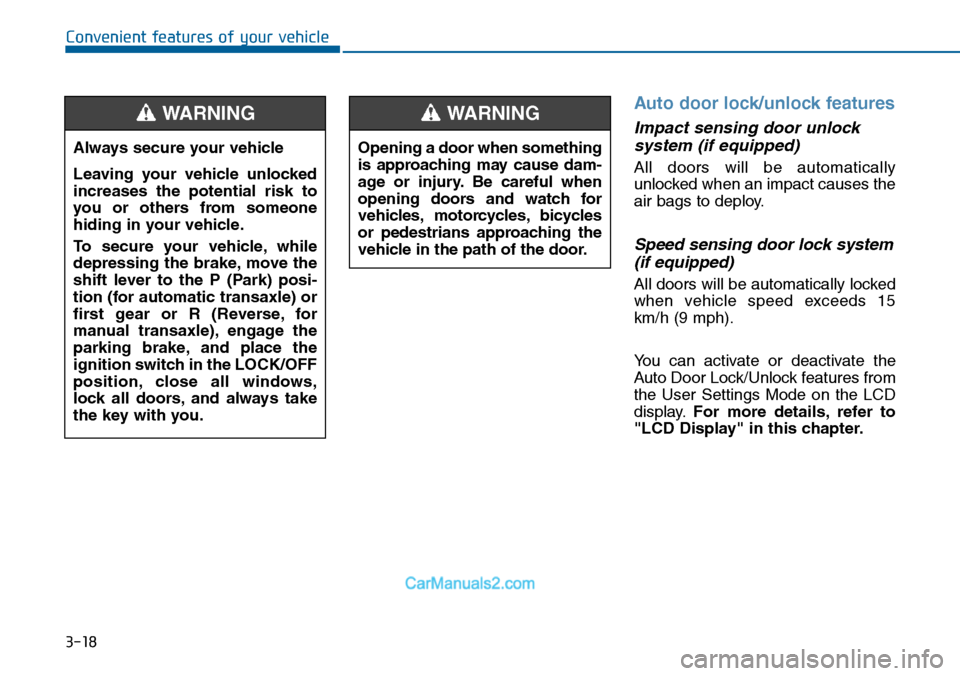
3-18
Convenient features of your vehicle
Auto door lock/unlock features
Impact sensing door unlock
system (if equipped)
All doors will be automatically
unlocked when an impact causes the
air bags to deploy.
Speed sensing door lock system
(if equipped)
All doors will be automatically locked
when vehicle speed exceeds 15
km/h (9 mph).
Yo u c a n a c t i v a t e o r d e a c t i v a t e t h e
Auto Door Lock/Unlock features from
the User Settings Mode on the LCD
display.For more details, refer to
"LCD Display" in this chapter.
Always secure your vehicle
Leaving your vehicle unlocked
increases the potential risk to
you or others from someone
hiding in your vehicle.
To secure your vehicle, while
depressing the brake, move the
shift lever to the P (Park) posi-
tion (for automatic transaxle) or
first gear or R (Reverse, for
manual transaxle), engage the
parking brake, and place the
ignition switch in the LOCK/OFF
position, close all windows,
lock all doors, and always take
the key with you.
WARNING
Opening a door when something
is approaching may cause dam-
age or injury. Be careful when
opening doors and watch for
vehicles, motorcycles, bicycles
or pedestrians approaching the
vehicle in the path of the door.
WARNING